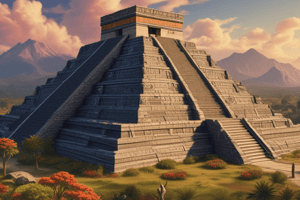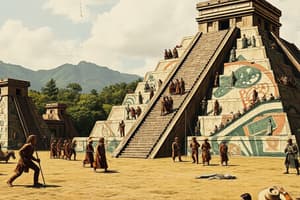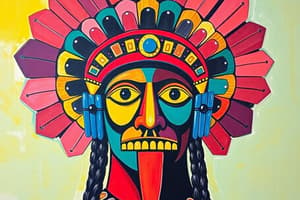Podcast
Questions and Answers
Who was the leader of the Chichimec invaders that arrived in 1244?
Who was the leader of the Chichimec invaders that arrived in 1244?
- Tepanec
- Tezozomoc
- Atzcapotzalco
- Xolotl (correct)
What geographical feature was especially attractive to nomadic peoples seeking a more abundant life?
What geographical feature was especially attractive to nomadic peoples seeking a more abundant life?
- The Valley of Anahuac's interconnecting lakes (correct)
- Dense forests teeming with wildlife
- Mountains rich in minerals
- Arid north plains
What significant marriage did Xolotl arrange to strengthen his influence?
What significant marriage did Xolotl arrange to strengthen his influence?
- He married a local agricultural leader.
- He married a Tepanec princess.
- He married a princess of the conquered Colhuacan. (correct)
- He married a Mexican princess.
What role did Tezozomoc play in the expansion of Tepanec power?
What role did Tezozomoc play in the expansion of Tepanec power?
Which cultural phenomenon occurred due to the interaction of different tribes in the Valley of Mexico?
Which cultural phenomenon occurred due to the interaction of different tribes in the Valley of Mexico?
What was the significance of the power vacuum created by the collapse of Tula in the twelfth century?
What was the significance of the power vacuum created by the collapse of Tula in the twelfth century?
Which language began to dominate the valley as the standing of the Chichimecs grew?
Which language began to dominate the valley as the standing of the Chichimecs grew?
What characterized the interactions between the newly arrived Chichimec and the established towns in the valley?
What characterized the interactions between the newly arrived Chichimec and the established towns in the valley?
What was the significant strategy used by the Tepanecs to expand their influence in the valley?
What was the significant strategy used by the Tepanecs to expand their influence in the valley?
What was one consequence of the frequent hostilities in the Valley of Mexico?
What was one consequence of the frequent hostilities in the Valley of Mexico?
What action did the Aztecs take after being granted freedom?
What action did the Aztecs take after being granted freedom?
What event horrified the Colhu lord?
What event horrified the Colhu lord?
How did the Aztecs respond to their difficult circumstances in the marshy region?
How did the Aztecs respond to their difficult circumstances in the marshy region?
What was the significance of the prophecy of Huitzilopochtli for the Aztecs?
What was the significance of the prophecy of Huitzilopochtli for the Aztecs?
What architectural feature did the Aztecs create to defend their city?
What architectural feature did the Aztecs create to defend their city?
Flashcards
Valley of Mexico (Anahuac)
Valley of Mexico (Anahuac)
The Valley of Mexico, also known as Anahuac, was a rich and fertile area that attracted nomadic groups from the arid north.
Cultural Melting Pot
Cultural Melting Pot
The Valley of Mexico was a place where different cultures met and exchanged ideas, goods, and customs, creating a rich and diverse environment.
Tula's Collapse and Chichimec Migration
Tula's Collapse and Chichimec Migration
The collapse of Tula (Toltec capital) in the 12th century led to a power vacuum in the Valley of Mexico, which attracted various groups of Chichimec people.
Chichimec Assimilation
Chichimec Assimilation
Signup and view all the flashcards
Growing Population and Competition
Growing Population and Competition
Signup and view all the flashcards
Chichimecs
Chichimecs
Signup and view all the flashcards
Xolotl
Xolotl
Signup and view all the flashcards
Atzcapotzalco
Atzcapotzalco
Signup and view all the flashcards
Tezozomoc
Tezozomoc
Signup and view all the flashcards
Mexica
Mexica
Signup and view all the flashcards
Aztec Request for a Culhua Queen
Aztec Request for a Culhua Queen
Signup and view all the flashcards
Aztec Sacrifice of the Princess
Aztec Sacrifice of the Princess
Signup and view all the flashcards
Aztec Settlement in Marshlands
Aztec Settlement in Marshlands
Signup and view all the flashcards
Aztec Founding of Tenochtitlan
Aztec Founding of Tenochtitlan
Signup and view all the flashcards
Tenochtitlan's Growth and Defense
Tenochtitlan's Growth and Defense
Signup and view all the flashcards
Study Notes
Chapter 4: The Rise of the Aztecs
- The Valley of Mexico (Anahuac) was attractive to nomadic groups due to its climate, resources, and lakes.
- The valley was a cultural crossroads, with diverse groups interacting and exchanging ideas.
- Frequent conflicts existed between various city-states in the 12th century.
- Central Mexico held the most influential role in this network of exchange and domination.
- Nahuatl-speaking Chichimecs entered the valley from the north in the 13th century, leading to increased population density and tension.
- Early Chichimecs adopted more advanced ways of life from existing sedentary groups.
- Xolotl, an important leader, established settlements and dominated northern parts of the valley through warfare.
- The Mexica (Aztecs), one of the groups, initially arrived late in the valley.
- Aztecs were viewed as unwelcome, aggressive squatters by earlier residents.
Aztec Rise to Power
- Aztecs were nomadic and came from Aztlan, a place believed located Northwest of the Valley.
- Aztecs moved to the valley and struggled to find acceptance.
- They had a complex relationship with the surrounding groups, engaging in conflict and alliances throughout a period of several decades of wandering until they settled on an island, eventually establishing Tenochtitlan.
- The Aztecs' success was attributed to a combination of adaptability, aggressive tactics, and reliance on alliances.
- Aztecs adopted farming methods from surrounding cultures.
- They built alliances, creating a system for tribute and expansion.
- Aztecs established a strong position in the valley.
Aztec Empire
- The Mexica formed the Triple Alliance with Texcoco and Tlacopan against the Tepanecs in 1428.
- The alliance controlled central Mexico and led to expansion.
- Nezahualcoyotl, a ruler of Texcoco, played a key role in developing art, literature, and engineering in Texcoco, which was a city-state allied with the Aztecs.
- During Itzcoatl's time (1428-1440), Aztec independence was established and the power of the Triple Alliance was strengthened.
- Moctezuma I (1440-1469) expanded the empire.
- Aztec expansion reached its peak under Ahuitzotl (1487-1502).
- Ahuitzotl expanded territory and trade routes.
Studying That Suits You
Use AI to generate personalized quizzes and flashcards to suit your learning preferences.




